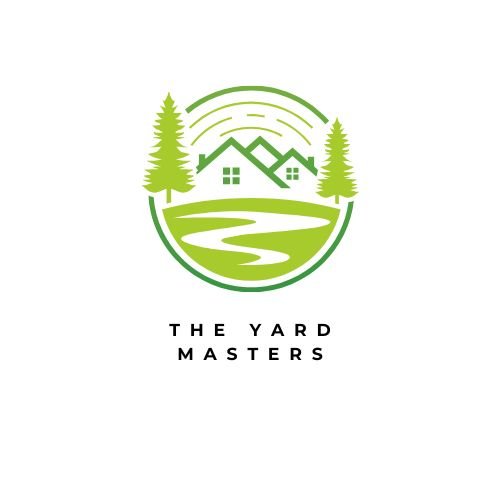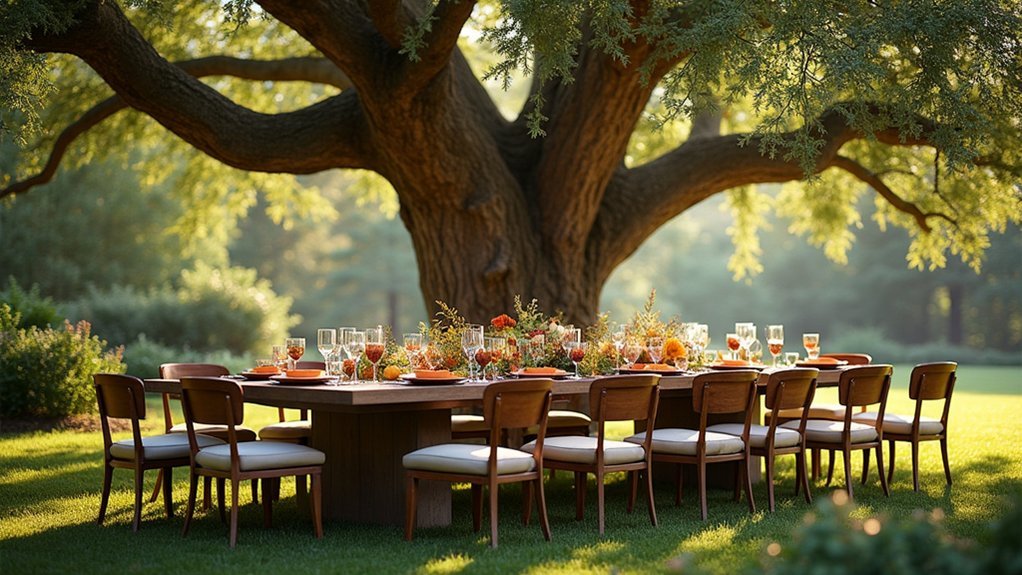When choosing an 8-person outdoor dining table, you’ll need to measure your space carefully, ensuring at least three feet of clearance around the table for movement. Select weather-resistant materials like teak, powder-coated aluminum, or all-weather rattan that can withstand UV rays and temperature extremes. Consider whether rectangular tables for large gatherings or round tables for intimate conversations better suit your entertaining style. Match the table height with appropriate seating, maintain proper legroom clearance, and choose designs that complement your existing outdoor decor using the 60-30-10 color rule. Understanding maintenance requirements will help you make the most informed decision for your outdoor entertainment space.
Measure Your Outdoor Space for Proper Table Fit

Before you fall in love with that perfect outdoor table, you’ll need to grab your tape measure and determine your space’s exact dimensions. Start by measuring the length and width of your outdoor area, then multiply these numbers to calculate your total square footage. This calculation helps you assess whether an 8-person table will comfortably fit.
Remember that a typical 8-person rectangular table measures around 8 feet long and 36-40 inches wide. You’ll need to maintain at least three feet of clearance around the entire table for comfortable movement and chair access.
Don’t forget to measure any existing furniture and subtract those dimensions from your total space. This prevents overcrowding and guarantees your outdoor dining area remains functional and inviting for gatherings.
Choose the Right Table Shape for Your Entertainment Style
Your entertainment style should drive your table shape decision.
If you’re hosting large dinner parties or family gatherings, rectangular tables give you the most seating and serving space.
For creating cozy, intimate conversations where everyone can easily chat, round tables work best since they naturally bring people together.
Rectangular for Large Groups
Rectangle tables excel when you’re hosting eight or more guests for outdoor dining.
These rectangular tables, typically measuring 96 inches long and 36-40 inches wide, provide ample space for place settings and centerpieces while ensuring you can accommodate everyone comfortably.
You’ll appreciate how the linear design promotes conversation flow and makes serving easier. The layout requires at least three feet of clearance around the perimeter, giving guests comfortable access to their seats.
Whether you’re placing it on your patio or in your garden, rectangular tables integrate seamlessly into various outdoor settings.
Many models offer extension options, so you can adapt when unexpected guests arrive.
This flexibility makes rectangular tables perfect for everything from intimate family dinners to larger entertaining occasions.
Round for Intimate Conversations
When you’re planning smaller, more intimate gatherings, round tables create the perfect atmosphere for meaningful conversations. With a minimum diameter of 72 inches, these tables eliminate obstructions that typically separate guests at rectangular designs.
You’ll find that everyone can easily see and interact with each other, fostering deeper connections during meals.
Round tables offer exceptional flexibility in seating arrangements, allowing you to accommodate additional guests without sacrificing comfort. The cornerless design naturally creates a more relaxed, casual dining atmosphere that encourages spontaneous discussions.
You’ll also appreciate how these tables require less space than rectangular options while still providing ample room for movement. This makes them perfect for medium-sized outdoor areas where you want to maximize both functionality and intimate conversations.
Select Weather-Resistant Materials for Long-Term Durability

The foundation of a long-lasting outdoor table starts with selecting materials that can withstand nature’s harsh elements year after year.
Smart material selection forms the cornerstone of outdoor furniture that endures seasons of sun, rain, and wind without compromise.
When investing in outdoor dining tables, you’ll want weather-resistant materials that guarantee long-term durability without constant maintenance.
Consider these superior material options:
- Teak wood – Its high natural oil content repels water and resists cracking, making your heart skip knowing it’ll weather any storm beautifully.
- Powder-coated aluminum frames – They prevent rust and corrosion, giving you peace of mind even in coastal environments.
- All-weather rattan – Withstands UV rays and extreme temperatures while maintaining that stylish appeal you crave.
- Tempered glass tops – Break-resistant and easy to clean, they’ll make entertaining effortless and elegant.
Consider Table Height and Seating Comfort Requirements
You’ll need to choose between three standard outdoor table heights: dining (28″–30″), counter (34″–36″), and bar (40″–42″) based on your seating style and comfort preferences.
Make sure there’s 10 to 13 inches of clearance between the table’s underside and seat tops to provide adequate legroom for your guests.
Your chair selection should prioritize ergonomic designs with proper back support, especially since outdoor gatherings often involve extended sitting periods.
Standard Height Options
Two primary height categories dominate outdoor table selection: standard dining height and bar height, each requiring specific seating arrangements for ideal comfort.
Standard height options range from 28 to 30 inches, perfectly paired with 18-inch seat height chairs. Bar-height tables measure 40 to 42 inches and need counter-height seating around 24 to 26 inches.
When selecting table height, you’ll want to guarantee adequate legroom by maintaining 10 to 13 inches between the table’s underside and seat tops.
Here’s what proper height selection delivers:
- Enhanced comfort during long outdoor gatherings
- Seamless conversation flow among all eight guests
- Effortless movement between seats without awkward crouching
- Cohesive aesthetic that complements your outdoor space’s design
Proper Legroom Clearance
Proper legroom clearance makes the difference between comfortable outdoor dining and cramped, awkward meals where guests constantly shift to find space.
You’ll need 10 to 13 inches between your table’s underside and seat tops for adequate legroom. Since outdoor dining tables typically measure 28 to 30 inches high, they’re compatible with standard chair heights for comfortable seating.
Don’t forget about clearance around the dining table—maintain at least three feet so guests can move freely without bumping into obstacles or each other.
Provide two feet of shoulder space per person to prevent crowding. Remember that table height affects comfort considerably, and round tables require extra attention to spacing since guests sit at varying angles around the perimeter.
Chair Compatibility Guidelines
Selecting chairs that match your outdoor table’s dimensions requires careful attention to seat height measurements. For standard 28-30 inch tables, you’ll need chairs with 18-20 inch seat heights to achieve proper 10-13 inch legroom clearance. This guarantees your guests won’t feel cramped during meals.
Consider these essential compatibility factors:
- Measure armchair clearance – Arms need 7-9 inches to slide under without scraping.
- Calculate shoulder space – Allow 24 inches per person to prevent uncomfortable crowding.
- Test chair seat height against your table before purchasing.
- Choose lightweight options for round tables to enable flexible seating arrangements.
Proper measurements prevent the frustration of discovering incompatible furniture after delivery.
You’ll create a comfortable dining experience where guests can relax and enjoy gatherings without physical discomfort.
Plan for Adequate Clearance and Movement Around the Table
One essential aspect of outdoor table placement involves ensuring you’ve got enough space around your dining area for comfortable movement and accessibility.
You’ll need at least three feet of adequate clearance around your table to prevent overcrowding during gatherings. This spacing allows for comfortable chair movement without obstructing pathways, enhancing your outdoor space’s overall flow.
Each guest requires at least two feet of shoulder space at the table for a relaxed dining experience.
When measuring, consider existing furniture placement since it impacts accessibility and layout around your table area.
Use a tape measure to accurately gauge your space, ensuring your 8-person table fits well within the designated area while maintaining necessary movement zones for peak functionality.
Match Your Table Design to Your Outdoor Decor Style

Your table’s design sets the visual tone for your entire outdoor dining area, making it essential to select one that harmonizes with your existing decor style.
Consider your space’s aesthetic when choosing materials and finishes that’ll create a cohesive look.
Apply the 60-30-10 color rule to balance your table’s hue with surrounding elements.
Here’s how to match your table design perfectly:
- Rustic farmhouse: Choose weathered wooden tables that’ll make guests feel like they’re dining in a countryside retreat.
- Modern contemporary: Select sleek metal or glass designs that’ll create an sophisticated urban oasis.
- Natural bohemian: Opt for rattan or teak materials that’ll transport everyone to a tropical paradise.
- Industrial chic: Pick concrete or steel tables that’ll give your space an edgy, gallery-like atmosphere.
Evaluate Maintenance Requirements and Care Instructions
While choosing an outdoor table that matches your aesthetic is important, understanding the maintenance requirements of different materials will determine how much time and effort you’ll spend keeping your investment looking its best.
Wooden outdoor dining sets, especially teak, need annual oiling to maintain color and prevent weather damage. Regular cleaning with warm soapy water handles day-to-day upkeep.
Rattan furniture requires simple wiping with damp cloths, plus occasional mild solution spraying for deeper cleaning. Aluminum frames offer the lowest maintenance—just rinse occasionally to remove grime.
Glass tabletops need microfiber cloths and glass cleaner to avoid streaks. Following proper care instructions extends your table’s lifespan considerably.
Always cover or store your dining set during inclement weather to protect against moisture and frost damage.
Frequently Asked Questions
How Big Should a Table Be to Seat 8 People?
You’ll need a rectangular table that’s 96 inches long and 36-40 inches wide, a round table with a 72-inch diameter, or a square table measuring 60-72 inches per side.
How Big of a Patio Do You Need for an 8 Person Table?
You’ll need a patio that’s at least 13 feet by 13 feet for an 8-person table. This provides space for the table itself plus essential 3-foot clearance around all sides for comfortable movement.
What Is a Good Size Outdoor Table?
You’ll want a rectangular table that’s 96 inches long and 36-40 inches wide, a 72-inch diameter round table, or a 60-72 inch square table for comfortable outdoor dining with eight people.
Can You Sit 10 People at an 8 Foot Table?
Yes, you can seat 10 people at an 8-foot table, though it’ll be tight. You’ll need to allow just 2 feet per person and consider using benches for more flexible seating arrangements.





Leave a Reply